Related Research Articles
1575 Winifred, provisional designation 1950 HH, is a stony Phocaea asteroid and slow rotator from the inner regions of the asteroid belt, approximately 9.5 kilometers in diameter.
2023 Asaph, provisional designation 1952 SA, is a dark asteroid from the outer regions of the asteroid belt, approximately 21 kilometers in diameter. It was discovered on 16 September 1952, by astronomers of the Indiana Asteroid Program at Goethe Link Observatory in Indiana, United States.
Arago, provisional designation 1923 OT, is a dark asteroid from the outer regions of the asteroid belt, approximately 55 kilometers in diameter. It was discovered on 5 September 1923, by Russian astronomer Sergey Belyavsky at the Simeiz Observatory on the Crimean peninsula. The asteroid was named after French mathematician François Arago.
Lagrangea, provisional designation 1923 OU, is a carbonaceous background asteroid from the outer region of the asteroid belt, approximately 30 kilometers in diameter. It was discovered on 12 September 1923, by Russian astronomer Sergey Belyavsky at the Simeiz Observatory on the Crimean peninsula. The asteroid was named after Italian mathematician and astronomer Joseph-Louis Lagrange.
1151 Ithaka, provisional designation 1929 RK, is a carbonaceous asteroid from the inner regions of the asteroid belt, approximately 14 kilometers in diameter. It was discovered by Karl Reinmuth at the Heidelberg-Königstuhl State Observatory in 1929, and later named for the Greek island of Ithaca.
6398 Timhunter, provisional designation 1991 CD1, is a stony Phocaea asteroid from the inner regions of the asteroid belt, approximately 5.5 kilometers in diameter. It was discovered on 10 February 1991, by American astronomer couple Carolyn and Eugene Shoemaker, in collaboration with Canadian astronomer David H. Levy at Palomar Observatory in California, United States. It was named for American amateur astronomer Tim Hunter.
2678 Aavasaksa, provisional designation 1938 DF1, is a stony Flora asteroid from the inner regions of the asteroid belt, approximately 8 kilometers in diameter.
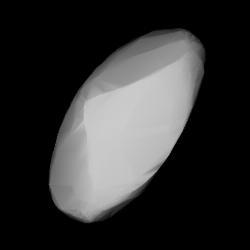
2839 Annette is a bright Flora asteroid from the inner regions of the asteroid belt. It was discovered on 5 October 1929, by American astronomer Clyde Tombaugh at Lowell Observatory during his search for Pluto. The presumed S-type asteroid has a rotation period of 10.5 hours and measures approximately 5 kilometers in diameter. It was named after the discoverer's daughter.
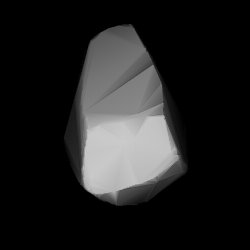
1335 Demoulina, provisional designation 1934 RE, is a stony Florian asteroid from the inner regions of the asteroid belt, approximately 7 kilometers in diameter. Discovered by Karl Reinmuth at Heidelberg Observatory in 1934, the asteroid was named after Prof. Demoulin, a Belgian astronomer at Ghent University. It has a slower-than average spin rate of nearly 75 hours.
3996 Fugaku, provisional designation 1988 XG1, is a stony Florian asteroid from the inner regions of the asteroid belt, approximately 5.5 kilometers in diameter. It was discovered on 5 December 1988, by Japanese amateur astronomers Masaru Arai and Hiroshi Mori at Yorii Observatory in central Japan. It was named for Mount Fuji, Japan.
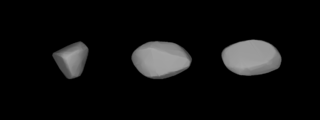
1930 Lucifer, provisional designation 1964 UA, is a carbonaceous asteroid from the outer regions of the asteroid belt, approximately 34 kilometers in diameter. It was discovered on 29 October 1964, by American astronomer Elizabeth Roemer at the Flagstaff station (NOFS) of the United States Naval Observatory (USNO). It is named after Lucifer, the "shining one" or "light-bearer" from the Hebrew Bible.
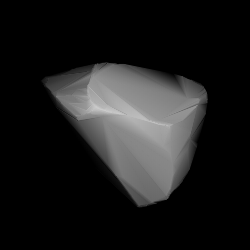
1582 Martir, provisional designation 1950 LY, is a carbonaceous background asteroid from the outer regions of the asteroid belt, approximately 37 kilometers in diameter. It was discovered on 15 June 1950, by Argentine astronomer Miguel Itzigsohn at the La Plata Astronomical Observatory in Argentina. The asteroid was named after the First Lady of Argentina, Eva Perón.
1680 Per Brahe, provisional designation 1942 CH, is a bright background asteroid from the central region of the asteroid belt, approximately 14 kilometers in diameter. It was discovered on 12 February 1942, by Finnish astronomer Liisi Oterma at Turku Observatory in Southwest Finland. The stony S-type asteroid has a rotation period of 3.4 hours. It is named after Swedish count and governor Per Brahe the Younger.
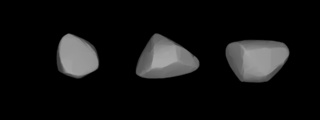
1518 Rovaniemi, provisional designation 1938 UA, is a stony Florian asteroid from the inner regions of the asteroid belt, approximately 8 kilometers in diameter. Discovered by Yrjö Väisälä at the Turku Observatory in 1938, the asteroid was later named after the Finnish city of Rovaniemi.
4176 Sudek, provisional designation 1987 DS, is a Themistian asteroid from the outer regions of the asteroid belt, approximately 17 kilometers in diameter. It was discovered on 24 February 1987, by Czech astronomer Antonín Mrkos at the Kleť Observatory in the Czech Republic. The presumed C-type asteroid has a rotation period of 8.16 hours. It was named in memory of Czech photographer Josef Sudek.
2391 Tomita, provisional designation 1957 AA, is a Nysian asteroid from the inner regions of the asteroid belt, approximately 15 kilometers in diameter. The asteroid was discovered on 9 January 1957, by German astronomer Karl Reinmuth at Heidelberg Observatory in southern Germany. It was named after Japanese astronomer Kōichirō Tomita.
3823 Yorii, provisional designation 1988 EC1, is a carbonaceous asteroid from the outer region of the asteroid belt, approximately 11 kilometers in diameter.
3628 Božněmcová, provisional designation 1979 WD, is a rare-type asteroid from the middle region of the asteroid belt, approximately 7 kilometers in diameter. It was discovered on 25 November 1979, by Czech astronomer Zdeňka Vávrová at Kleť Observatory in the Czech Republic. It is named for Czech writer Božena Němcová.
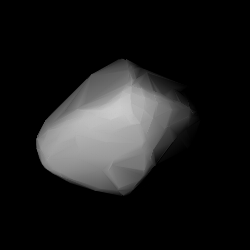
1422 Strömgrenia, provisional designation 1936 QF, is a stony Florian asteroid from the inner regions of the asteroid belt, approximately 5.5 kilometers in diameter. It was discovered on 23 August 1936, by German astronomer Karl Reinmuth at Heidelberg Observatory in southern Germany, and named after Swedish-Danish astronomer Svante Elis Strömgren.
10208 Germanicus, provisional designation 1997 QN1, is a stony Florian asteroid and binary system from the inner regions of the asteroid belt, approximately 3.5 kilometers in diameter.
References
- 1 2 3 4 "JPL Small-Body Database Browser: 4217 Engelhardt (1988 BO2)" (2017-06-05 last obs.). Jet Propulsion Laboratory . Retrieved 4 July 2017.
- 1 2 Schmadel, Lutz D. (2007). "(4217) Engelhardt". Dictionary of Minor Planet Names – (4217) Engelhardt. Springer Berlin Heidelberg. p. 361. doi:10.1007/978-3-540-29925-7_4182. ISBN 978-3-540-00238-3.
- 1 2 3 4 5 6 "LCDB Data for (4217) Engelhardt". Asteroid Lightcurve Database (LCDB). Retrieved 4 April 2017.
- 1 2 "Asteroid 4217 Engelhardt – Nesvorny HCM Asteroid Families V3.0". Small Bodies Data Ferret. Retrieved 27 October 2019.
- 1 2 3 Warner, Brian D. (April 2012). "Asteroid Lightcurve Analysis at the Palmer Divide Observatory: 2011 September - December". The Minor Planet Bulletin. 39 (2): 69–80. Bibcode:2012MPBu...39...69W. ISSN 1052-8091 . Retrieved 4 April 2017.
- 1 2 3 Nugent, C. R.; Mainzer, A.; Masiero, J.; Bauer, J.; Cutri, R. M.; Grav, T.; et al. (December 2015). "NEOWISE Reactivation Mission Year One: Preliminary Asteroid Diameters and Albedos". The Astrophysical Journal. 814 (2): 13. arXiv: 1509.02522 . Bibcode:2015ApJ...814..117N. doi:10.1088/0004-637X/814/2/117 . Retrieved 4 April 2017.
- 1 2 3 4 Mainzer, A.; Grav, T.; Masiero, J.; Hand, E.; Bauer, J.; Tholen, D.; et al. (November 2011). "NEOWISE Studies of Spectrophotometrically Classified Asteroids: Preliminary Results". The Astrophysical Journal. 741 (2): 25. arXiv: 1109.6407 . Bibcode:2011ApJ...741...90M. doi:10.1088/0004-637X/741/2/90.
- 1 2 Masiero, Joseph R.; Mainzer, A. K.; Grav, T.; Bauer, J. M.; Cutri, R. M.; Dailey, J.; et al. (November 2011). "Main Belt Asteroids with WISE/NEOWISE. I. Preliminary Albedos and Diameters". The Astrophysical Journal. 741 (2): 20. arXiv: 1109.4096 . Bibcode:2011ApJ...741...68M. doi:10.1088/0004-637X/741/2/68 . Retrieved 4 April 2017.
- 1 2 3 Tedesco, E. F.; Noah, P. V.; Noah, M.; Price, S. D. (October 2004). "IRAS Minor Planet Survey V6.0". NASA Planetary Data System. 12: IRAS-A-FPA-3-RDR-IMPS-V6.0. Bibcode:2004PDSS...12.....T . Retrieved 22 October 2019.
- 1 2 Warner, Brian D. (June 2005). "Asteroid lightcurve analysis at the Palmer Divide Observatory - fall 2004". The Minor Planet Bulletin. 32 (2): 29–32. Bibcode:2005MPBu...32...29W. ISSN 1052-8091 . Retrieved 4 April 2017.
- 1 2 Veres, Peter; Jedicke, Robert; Fitzsimmons, Alan; Denneau, Larry; Granvik, Mikael; Bolin, Bryce; et al. (November 2015). "Absolute magnitudes and slope parameters for 250,000 asteroids observed by Pan-STARRS PS1 - Preliminary results". Icarus. 261: 34–47. arXiv: 1506.00762 . Bibcode:2015Icar..261...34V. doi:10.1016/j.icarus.2015.08.007 . Retrieved 4 April 2017.
- 1 2 "4217 Engelhardt (1988 BO2)". Minor Planet Center. Retrieved 4 April 2017.
- ↑ Giorgini, J. D.; Ostro, S. J.; Benner, L. A. M.; Chodas, P. W.; Chesley, S. R.; Hudson, R. S.; et al. (April 2002). "Asteroid 1950 DA's Encounter with Earth in 2880: Physical Limits of Collision Probability Prediction" (PDF). Science. 296 (5565): 132–136. Bibcode:2002Sci...296..132G. doi:10.1126/science.1068191. PMID 11935024. Archived from the original (PDF) on 4 July 2008. Retrieved 4 April 2017.
- ↑ "MPC/MPO/MPS Archive". Minor Planet Center. Retrieved 4 April 2017.